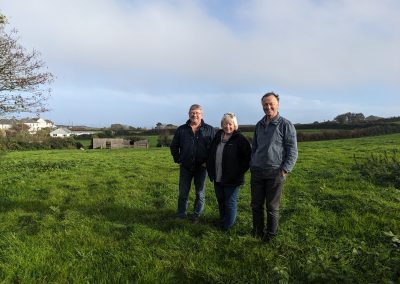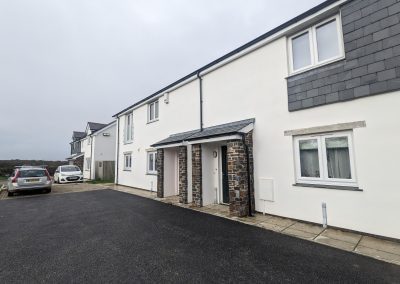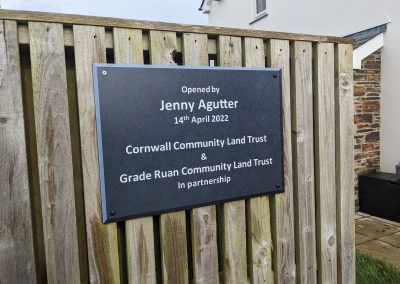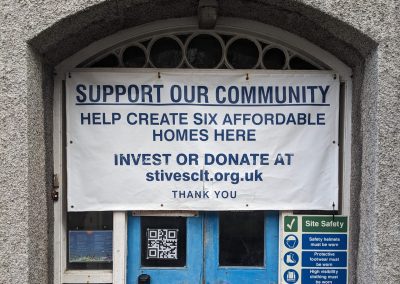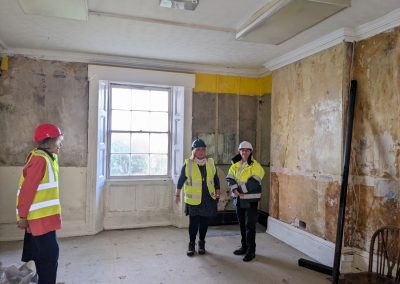Our chief executive, Tom, spent a few days in Cornwall, speaking at a conference and meeting some CLT staff and volunteers. He writes some reflections on the trip, including how communities can fight back against the housing crisis, what we mean by community, and how we scale CLTs in the county.
‘I haven’t had the heating on yet’, beamed a CLT tenant in Ruan Minor as her son peeked at us through the front window.
She and her family are among six households local to the Lizard Peninsula of Cornwall who have been given a place to live in warm, modern homes with a genuinely affordable rent. These homes were completed in September 2021 and opened by local resident, actor and CLT supporter Jenny Agutter.
(Because of Cornwall CLT’s high construction standards, the development is also home to birds, bees, bats and hedgehogs.)
This was the 27th project completed by Cornwall CLT in 13 years. They’re a rare example in our movement of an ability to develop at some scale. Along with the many Middlemarch-enabled projects across the Tamar they’re credited by Homes England with a significant uptick in rural affordable house building in the South West.
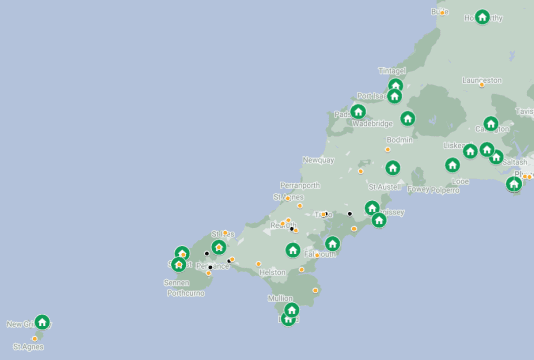
The green houses on this map represent live housing and non-housing projects, orange dots represent projects that are looking for a site, getting planning permission or currently building, and a grey dot represents CLTs forming their groups.
Within our sector, they represent 14% of completed homes in a county with less than 1% of the population of England and Wales.
Cornwall CLT has used every tool in the box – direct development and partnerships with private developers and housing associations; enabling self build and conventional construction; developing with hyper-local CLTs and also building their own county-wide portfolio.
The latter point – a county-wide CLT – makes them unique in rural England and Wales. They’re a bit like citywide CLTs – Bristol CLT, London CLT – in working with both a county-wide community of purpose (their members) and local communities of neighbours (who design and/or live in their homes). I spent some time talking with Andrew and Pattie from Cornwall CLT about what we mean by community and how you keep this at the heart of a rapidly-growing organisation.
It’s becoming more relevant as the sheer desperation of Cornwall communities brings them to Cornwall CLT’s door. We contributed to a report by the think tank Localis on housing pressures in holiday hotspots, published in August. Meeting residents and noting the ‘holiday cottage’ signs as I walked through the villages and towns, the impact was all too clear. Communities hollowed out by holiday lets, local workers forced to live in vans or commute long distances, young families living with the grandparents.
In many towns and villages, I was told that larger merged housing associations have also been selling off stock to consolidate in the bigger and lower value towns. It helps to increase the overall stock county-wide, but leaves many local communities with little or no access to affordable housing.
Local people determined to fight back are forming ‘housing working parties’ to work with Cornwall CLT to identify the local needs, find and secure a site, and get affordable homes built, including persuading their neighbours of the need and overcoming opposition. They’re a sort of rural YIMBY alliance. A minority want to go one step further and form their own local CLT, which might in time also take on other needs such as shops, pubs, workspace and nature restoration. Most are happy to work under the wings of Cornwall CLT, reassured that the homes will be permanently protected for people with a local connection.
In St Ives I met half a dozen members of a very dynamic local CLT, which has been supported by Cornwall CLT and CLT Network over the years.
They showed me around the Old Vicarage, a dilapidated building they bought some years ago from the council (which owned the ground floor community rooms) and a housing association (which owned six flats above). They’re determined to stop assets like this turning into yet-more holiday homes.
As you can see the building needs a fair bit of work. They’ve stripped it all back to remove asbestos and replaced the roof which was leaking – all during the COVID pandemic. But like the Peninsula Trust and the nascent Looe CLT, they’re determined to bring the building up to high environmental standards, e.g. not taking the cheaper short-term option of new gas boilers.Sadly they are locked in a negotiation with Cornwall Council over Town Deal funding. Like too many CLTs, they have felt as though officials have frustrated them every step of the way, and then knock them for being slow to complete projects.
But like many CLTs their team is pretty unstoppable – they run an outreach shop and community space nearby, led efforts to create a ground-breaking ‘town charter’ setting up the needs and aspirations of the community, a member has composed a song for St Ives, they led the mutual aid efforts during COVID, they have been negotiating with other building owners to create new artists and craft studio spaces as well as affordable homes.
I spent some time talking with them about our national strategy to scale up the CLT movement. We recently discussed a long-term strategy with the housing minister, which focused on building up the capabilities of regional developers/enablers like Cornwall CLT, improving their access to capital (particularly risk-capital for pre-development work), and tweaking planning and affordable housing policies to grease the wheels of their work.
Local CLTs like those in St Ives, as well as working parties across the county, would welcome Cornwall CLT being able to step in and deliver projects with them. To do a lot of the heavy lifting, enabling them to focus on the details that really matter to local people, and on the long-term stewardship of those assets for community wellbeing.
This will be central to our CLT manifesto for the next general election. The team in St Ives are ready to lobby their prospective parliamentary candidates once we publish it, and we’ll be organising our members across England and Wales to make the case for a community-led answer to the housing crisis. Watch this space!

